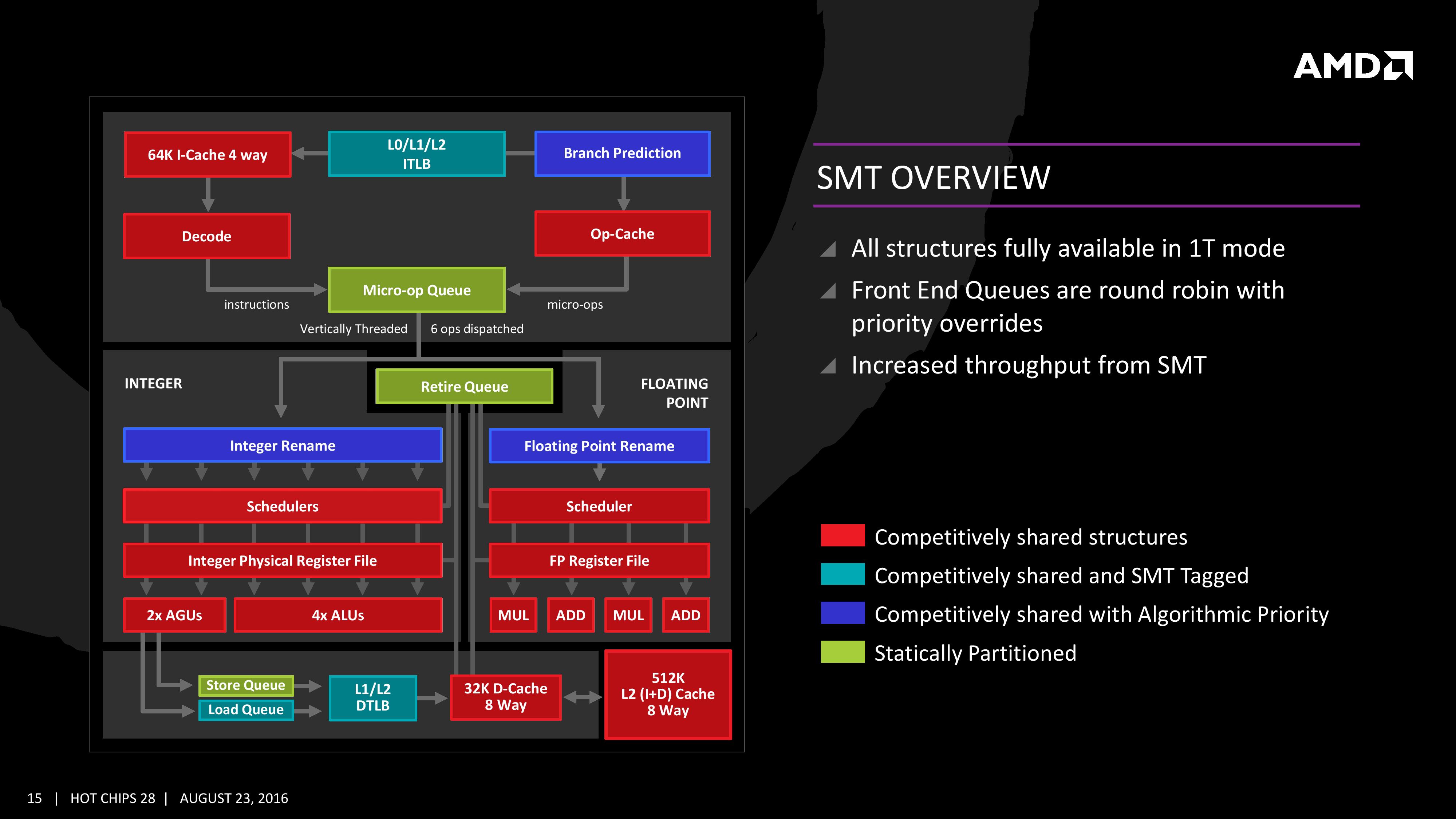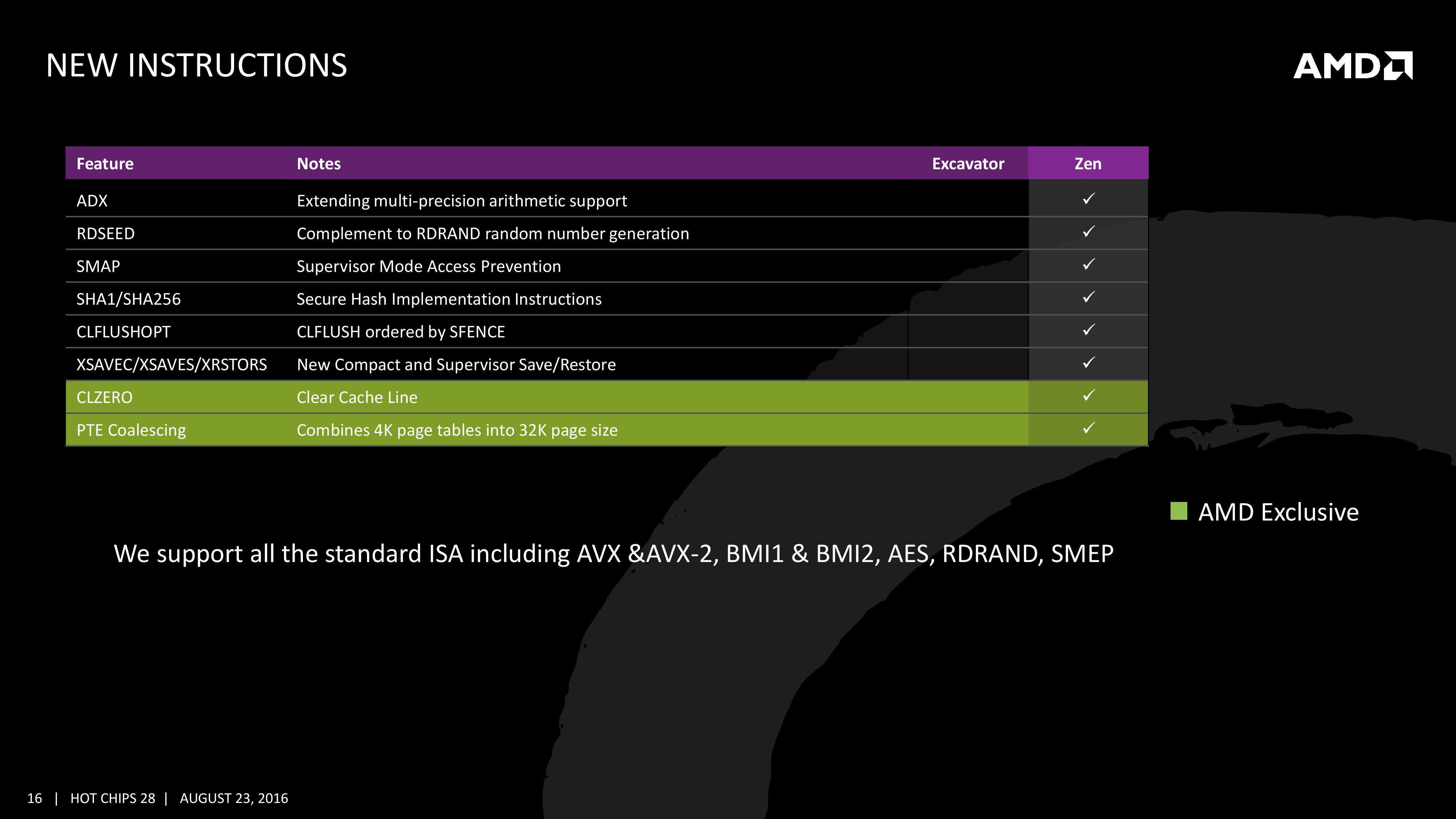AMD Zen Microarchiture Part 2: Extracting Instruction-Level Parallelism
by Ian Cutress on August 23, 2016 8:45 PM EST- Posted in
- CPUs
- AMD
- x86
- Zen
- Microarchitecture
Simultaneous MultiThreading (SMT)
Zen will be AMD’s first foray into a true simultaneous multithreading structure, and certain parts of the core will act differently depending on their implementation. There are many ways to manage threads, particularly to avoid stalls where one thread is blocking another that ends in the system hanging or crashing. The drivers that communicate with the OS also have to make sure they can distinguish between threads running on new cores or when a core is already occupied – to achieve maximum throughput then four threads should be across two cores, but for efficiency where speed isn’t a factor, perhaps power gating/clock gating half the cores in a CCX is a good idea.
There are a number of ways that AMD will deal with thread management. The basic way is time slicing, and giving each thread an equal share of the pie. This is not always the best policy, especially when you have one performance dominant thread, or one thread that creates a lot of stalls, or a thread where latency is vital. In some methodologies the importance of a thread can be tagged or determined, and this is what we get here, though for some of the structures in the core it has to revert to a basic model.
With each thread, AMD performs internal analysis on the data stream for each to see which thread has algorithmic priority. This means that certain threads will require more resources, or that a branch miss needs to be prioritized to avoid long stall delays. The elements in blue (Branch Prediction, INT/FP Rename) operate on this methodology.
A thread can also be tagged with higher priority. This is important for latency sensitive operations, such as a touch-screen input or immediate user input elements required. The Translation Lookaside Buffers work in this way, to prioritize looking for recent virtual memory address translations. The Load Queue is similarly enabled this way, as typically low latency workloads require data as soon as possible, so the load queue is perfect for this.
Certain parts of the core are statically partitioned, giving each thread an equal timing. This is implemented mostly for anything that is typically processed in-order, such as anything coming out of the micro-op queue, the retire queue and the store queue.
The rest of the core is competitive, meaning that if a thread demands more resources it will try to get there first if there is space to do so each cycle.
New Instructions
AMD has a couple of tricks up its sleeve for Zen. Along with including the standard ISA, there are a few new custom instructions that are AMD only.
Some of the new commands are linked with ones that Intel already uses, such as RDSEED for random number generation, or SHA1/SHA256 for cryptography. The two new instructions are CLZERO and PTE Coalescing.
The first, CLZERO, is aimed to clear a cache line and is more aimed at the data center and HPC crowds. This allows a thread to clear a poisoned cache line atomically (in one cycle) in preparation for zero data structures. It also allows a level of repeatability when the cache line is filled with expected data. CLZERO support will be determined by a CPUID bit.
PTE (Page Table Entry) Coalescing is the ability to combine small 4K page tables into 32K page tables, and is a software transparent implementation. This is useful for reducing the number of entries in the TLBs and the queues, but requires certain criteria of the data to be used within the branch predictor to be met.












106 Comments
View All Comments
tipoo - Wednesday, August 31, 2016 - link
Bulldozers engineering samples were 2.5GHz and that shipped stupid high clocked. Zen ESs being 3GHz doesn't worry me.Cooe - Thursday, May 6, 2021 - link
Holy CRAP did history ever make you look like an absolute freaking idiot! xDextide - Monday, August 29, 2016 - link
Well, they have already shown an 8-core Zen running at full load at 3Ghz with their regular OEM heatsink/fans, and those are rated at 125W TDP max, so we do already know that's possible.defter - Wednesday, August 24, 2016 - link
It's 40% IPC improvement, not 40% overall improvement. If you improve IPC by 40% and achieve 85% of the clock speed, the total improvement will be only 20%.Since AMD hasn't talked about clock speed we can assume that it will be lower than Bulldozer.
euskalzabe - Wednesday, August 24, 2016 - link
Let me fix that for you: "Since AMD hasn't talked about clock speed we can assume..." absolutely nothing and can only wait until the final product is released.retrospooty - Wednesday, August 24, 2016 - link
Actually he is right and probably understating it. If AMD says it qill have 40% IPC improvement, it is probably not true, or true only in a few select benchmarks. If AMD left out the clockspeed it is almost definitely going to lower. AMD has zero credibility with pre-release performance claims. Nothing AMD says can be takes at its word until retail units (not engineering samples) are independently tested.Azix - Wednesday, August 24, 2016 - link
why the flying fork would the clock speed be lower? I hope you dont mean lower than they have shown, that would make no sense.Bulldozer engineering samples were maybe 2.5Ghz or 3Ghz. Additionally, talking about actual clock speeds would be to give away sku information. How they plan to structure the product line etc.
Outlander_04 - Thursday, August 25, 2016 - link
Both intel Broadwell-e and Zen were at 3 Ghz for the comparison .Broadwell-e maxes out at 3.6 Ghz , but most models are at 3.2 Ghz .
Dont let your prejudices cause you to jump to conclusions.
Zen could easily be released running at higher clock rates
silverblue - Wednesday, August 24, 2016 - link
Imagine for a second that Zen was clocked like the FX-8320E, that is a 3.2GHz base with 4.0GHz boost. Would a 40 to 50% average IPC boost make Zen competitive?For all we know, Zen could be conservatively clocked, paving the way for Zen+ with moderate tweaks and increased clocks; a bit like Piledriver vs. Bulldozer, as opposed to Phenom II vs. Phenom.
looncraz - Wednesday, August 24, 2016 - link
Zen will clock very close to 4Ghz out of the box - AMD kept most of the speed-demon elements of Bulldozer, such as the long pipelines. They also used dedicated, simple, schedulers - which is where frequency limits are frequently found... and they also put the L3 cache on a different clock bus, meaning it might operate at a different frequency from the cores... again.The engineering samples are always clocked low, so if they are running at 3Ghz for a demo, then they will be able to achieve at least 3.4~3.6Ghz, with 4Ghz boost clocks on eight-core CPUs. Quad core units will obviously go higher, still. That is why half the cores still has 70% of the power draw - it's operating higher up the frequency curve. 3.8Ghz base, 4.2Ghz boost for the top quad core SKU seems very likely given what is known.